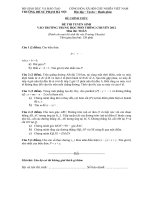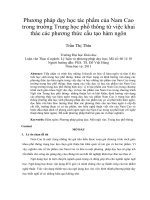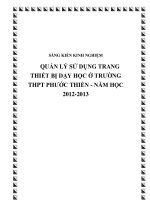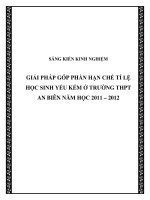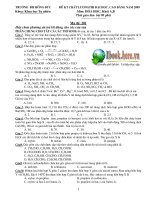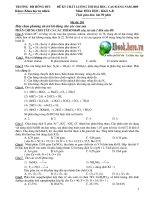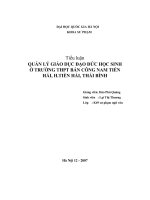ĐỀ THI THỬ TIẾNG ANH TRƯỜNG THPT lần 2 viet yen so 1 (20162017)
Bạn đang xem bản rút gọn của tài liệu. Xem và tải ngay bản đầy đủ của tài liệu tại đây (550.07 KB, 10 trang )
SỞ GD&ĐT BẮC GIANG
TRƯỜNG THPT VIỆT YÊN SỐ 1
ĐỀ THI THI THỬ THPT QG LẦN 2 NĂM HỌC 2016 – 2017
MÔN: TIẾNG ANH
Thời gian làm bài: 60 phút
(Học sinh làm bài trên phiếu trả lời trắc nghiệm)
Họ, tên thí sinh: ........................................................ SBD: .....................
Mã đề thi 283
Mark the letter A, B, C or D on your answer sheet to indicate the word that differs from the other
three in the position of the primary stress in each of the following questions.
Question 1: A. compulsory
B. certificate
C. significant
D. category
Question 2: A. history
B. confide
C. result
D. suggest
Mark the letter A, B, C or D on your answer sheet to indicate the sentence that is closest in meaning
to each of the following questions.
Question 3: “Leave my house now or I‟ll call the police!” shouted the lady to the man.
A.
B.
C.
D.
The lady said she would call the police if the man didn‟t leave her house.
The lady told the man that she would call the police he didn‟t leave her house.
The lady informed the man that she would call the police if he didn‟t leave her house.
The lady threatened to call the police if the man didn‟t leave her house.
Question 4: He last has his eyes tested ten months ago.
A.
B.
C.
D.
He had tested his eyes ten months before.
He didn‟t have any test on his eyes ten months before.
He had not tested his eyes for ten months then.
He hasn‟t had his eyes tested for ten months.
Question 5: He survived the operation thanks to the skillful surgeon.
A.
B.
C.
D.
He survived because he was a skillful surgeon.
He wouldn‟t have survived the operation without the skillful surgeon.
There was no skillful surgeon, so he died.
Though the surgeon was skillful, he couldn‟t survive the operation.
Mark the letter A, B, C or D on your answer sheet to indicate the word(s) OPPOSITE in meaning to
the underlined word(s) in each of the following questions.
Question 6: My younger brothers are obedient most of the time, but they are quite mischievous
sometimes
A. naughty
B. hard-working
C. well-behaved
D. disruptive
Question 7: You should not wear casual clothes to the interview. The first impression is very important.
A. new
B. informal
C. neat
D. formal
Mark the letter A, B, C or D on your answer sheet to indicate the word(s) CLOSEST in meaning to
the underlined word(s) in each of the following questions.
Question 8: In daily communication, you should know how to interpret other people‟s body language.
A. understand
B. answer
C. respond
D. notice
Question 9: The purpose of this survey is to determine students‟ attitudes toward love and marriage.
A. find out
B. develop
C. concern
D. build
Read the following passage and mark the letter A, B, C, D on your answer sheet to indicate the
correct answer to each of the questions from 10 to 17.
Who talks more – men or women? Most people believe that women talk more. However, linguist
Deborah Tannen, who has the studied the communication style of men and women, says that this is a
stereotype. According to Tannen, women are more verbal – talk more – in private situations, where
they use conversation as the “glue” to hold relationship together. But, she says, men talk more in public
situations, where they use conversation to exchange information and gain status. Tannen points out that
we can see these difference even in children. Little girls often play with one „best friend‟ and their play
includes a lot of conversation. Little boys often play games in groups, their play usually involves more
doing than talking. In school, girls are often better at verbal skills, while boys are often better at
mathematics.
A recent study at Emory University helps to shed light on the roots of this difference. Researchers
studied conversation between children aged 3-6 and their parents. They found evidence that parents
talk very differently to their sons than they do to their daughters. The startling conclusion was that
parents use more language with their girls. Specifically, when parents talk with their daughters, they
use more descriptive language and more details. There is also far more talk about emotions, especially
with daughters than with sons.
Question 10: Which sentence best expresses the main idea of the first paragraph?
A.
B.
C.
D.
Women talk more than men on the whole
Women‟s talking is a stereotype
Women talk more in private, and men talk more in public
Little boys and little girls have different ways of playing
Question 11: Which word is similar in meaning to the word “glue”?
A. games
B. sticky substance
C. rope
D. means
Question 12: Which of the following phrases best explains the meaning of the word “verbal”?
A. deriving from verbs
B. connected with use of spoken language
C. using very loud noise
D. being very talkative
Question 13: The word “they” refers to ______.
A. situations
D. women
E.
Question 14: Which of the following can be inferred from the first paragraph?
A.
B.
C.
D.
B. men
C. men and women
Men and women have different styles of talking, which may begin in childhood.
According to Deborah Tannen, the belief that women talk more is party right but most wrong.
Women talk more in some situations while men talk in others
Men are more sociable than women
Question 15: Which sentence best expresses the main idea of the second paragraph?
A. Researchers have studied the conversations of children and their parents.
B. Parents do not much about sadness with their sons.
C. Study at Emory University can help to explain the differences between communication styles of
boy and girls.
D. An Emory University study found than parent talk more with their daughters than with their
sons.
Question 16: which word can best replace the word “startling”?
A. Beginning
B. annoying
C. surprising
D. interesting
Question 17: Which of the following statement is TRUE about the passage?
A.
B.
C.
D.
Parents give more love to their daughters than to their sons
Boys don‟t like to be with their parents as much as girls do
Parents use more language to talk with their daughters
Boys don‟t like showing emotions
Read the following passage and mark the letter A, B, C, D on your answer sheet to indicate the
correct answer to each of the questions from 18 to 22.
Face-to-face conversation is a two-way process: You speak to me, I reply to you and so on. Twoway (18)_______ depends on having a coding system that is understood by both sender and
(19)_______, and an agreed convention about signaling the beginning and end of the message. In
speech, the coding system is the language like English or Spanish; the convention that one person
speaks at a time may seem too obvious to mention. In fact, the signals (20)_______ in conversation and
meetings are often (21)_______. For example, lowering the pitch of the voice may mean the end of a
sentence, a sharp intake of breath may signal the desire to interrupt, catching the chairman‟s eye may
indicate the desire to speak in a formal setting like a debate, a clenched fist may indicate anger. When
(22)_______ visual signals are not possible, more formal signals may be needed.
Question 18: A. exchange
B. interchange
C. communication
D. correspondence
Question 19: A. announcer
B. receiver
C. messenger
D. transmitter
Question 20: A. that people use
B. are used
C. using
D. being used
Question 21: A. informal
B. non-verbal
C. verbal
D. formal
Question 22: A. their
B. these
C. this
D. that
Mark the letter A, B, C or D on your answer sheet to indicate the correct answer to each of the
following questions.
Question 23: The state school system is free for all students and _______ by the government.
A. is paid for
B. is paying for
C. pays for
D. is being pay for
Question 24: Jane got married_______ Peter two years ago, but now they have split
A. as
B. with
C. for
D. to
Question 25: The H5N1 infected patients have to _______ others to prevent the virus from spreading
A. take care of
B. get away
C. look after
D. stay away from
Question 26: Whenever I have problems, Jane is always very dependable. She never ___.
A. turns up
B. let me down
C. turns me off
D. turns out
Question 27: Students are expected to write their homework slowly and _______.
A. careless
B. carefully
C. carelessly
D. careful
Question 28: During the interview, you should try to ____ a good impression on your interview.
A. create
B. have
C. give
D. try
Question 29: An academic year in Vietnam is divided _____ two terms
A. in
B. into
C. within
D. from
Question 30: Global warming is obviously _______ a worrying influence on the climate worldwide
A. having
B. making
C. giving
D. taking
Question 31: He wanted to know whose car I borrowed _____
A. yesterday evening B. the last evening
C. last night
D. the previous night
Question 32: The man to _______ we have just talked is the Director General
A. who
B. that
C. whom
D. 0
Question 33: Though built in 1946, computers were sold ______ for the first time in the 1950s
A. commercial
B. commercialise
C. commercially
D. commerce
Question 34: ______hard, you will get good results in the coming examination.
A. should you work B. unless you work
C. if you will work D. if work
Read the following passage and mark the letter A, B, C, D on your answer sheet to indicate the
correct answer to each of the questions from 35 to 41.
Stars have been significant features in the design of many United States coins and their number has
varied from one to forty-eight stars. Most of the coins issued from about 1799 to the early years of the
twentieth century bore thirteen stars representing the thirteen original colonies.
Curiously enough, the first American silver coins, issued in 1794, had fifteen stars because by that
time Vermont and Kentucky has joined the Union. At that time it was apparently the intention of mint
officials to add a star for each new state. Following the admission of Tennessee in 1796, for example,
some varieties of half dimes, dimes, and half-dollars were produced with sixteen starts.
As more states were admitted to the Union, however, it quickly became apparent that this scheme
would not prove practical and the coins from A798 on were issued with only thirteen stars-one for each
of the original colonies. Due to an error at the mint, one variety of the A828 half cent was issued with
only twelve stars. There is also a variety of the large cent with only A2 stars, but this is the result of a
die break and is not a true error.
Question 35: What is the main topic of the passage?
A.
B.
C.
D.
Stars on American coins
The teaching of astronomy in state universities
The star as national symbol of the United States
Colonial stamps and coins
Question 36: The word “their” in line 1 refers to _______
A. coins
B. features
C. colonies
D. stars
Question 37: The word “bore” in line 3 is closest in meaning to ________
A. carried
B. drilled
C. symbolized
D. cost
Question 38: The expression “Curiously enough” is used because the author finds it strange that
_______
A.
B.
C.
D.
Silver coins with fifteen stars appeared before coins with thirteen
Vermont and Kentucky joined the Union in 1794
Tennessee was the first state to use half dimes
No silver coins were issued until 1794
Question 39: Which of the following can be inferred about the order in which Kentucky, Tennessee,
and Vermont joined the Union?
A. Vermont joined after Tennessee and Kentucky.
B. Kentucky joined before Tennessee and Vermont.
C. Tennessee joined Vermont and Kentucky.
D. Vermont and Kentucky joined at the same time.
Question 40: Which of the following is NOT mentioned as the denomination of an American coin?
A. Half cent
B. Half-dollar
C. Half dime
D. Half nickel
Question 41: Why was a coin produced in 1828 with only twelve stars?
A. There was a change in design policy.
B. There were twelve states at the time.
C. The mint made a mistake.
D. Tennessee had left the Union.
Mark the letter A, B, C, or D on your answer sheet to indicate the underlined part that needs
correction in each of the following questions.
Question 42: (A)If you take (B)the train, it (C)would be (D)much more convenient.
Question 43: (A)Some of his favourite (B)subjects at school (C)are Maths, English and
(D)Geographical.
Question 44: (A)Could you tell (B)me (C)how can I get to (D)the city library, please?
Mark the letter A, B, C or D on your answer sheet to indicate the sentence that best combines each
pairs of sentences in the following questions.
Question 45: They were rich; they didn‟t have a happy family, though.
A.
B.
C.
D.
Although they were rich, but they didn‟t have a happy family.
Rich though they were, they didn‟t have a happy family.
They were rich although they didn‟t have a happy family.
However they were rich, they didn‟t have a happy family.
Question 46: One student failed because he completely ignored the instruction on the paper. The
instructions appeared on the top of every page.
A. One student failed because he completely ignored the instructions appearing on the top of every
page on the paper.
B. Even though one student ignored the instructions printed on the top of every paper, he failed.
C. One student failed to ignore the instructions printed on the top of every page of paper.
D. No matter how completely one student ignored the instructions printed on the top of every page
of the paper, he failed.
Mark the letter A, B, C or D on your answer sheet to indicate the most suitable response to complete
each of the following exchanges.
Question 47: Peter and Bob are talking about the plan for tonight.
Peter: “_________________.”
Bob: “I‟d love to. Thank you.”
A.
B.
C.
D.
Would you like to go to the new coffee shop with me?
What would you do if you can afford a new car?
Would you like a cake?
Why do you spend so much time playing games?
Question 48: Two people are talking on the phone.
A: “Could I speak to Alex, please?”
B: “___________________.”
A.
B.
C.
D.
Can I take the message?
I‟m sorry. Alex is not in.
Just a moment. I‟m coming.
This is Joe speaking.
Mark the letter A, B, C or D on your answer sheet to indicate the word whose underlined part differs
from the other three in pronunciation in each of the following questions.
Question 49: A. imports
B. groups
C. techniques
D. computers
Question 50: A. technology
B. chores
C. schooling
D. chemistry
HƯỚNG DẪN GIẢI CHI TIẾT
Thực hiện: Ban Chuyên môn Tuyensinh247.com
1. D
11. B
21. C
31. D
41. C
2. A
12. B
22. B
32. C
42. C
3. D
13. B
23. A
33. C
43. D
4. D
14. C
24. D
34. A
44. C
5. B
15. D
25. D
35. A
45. B
6. A
16. D
26. B
36. D
46. A
7. A
17. C
27. B
37. B
47. A
8. A
18. D
28. A
38. A
48. B
9. A
19. B
29. B
39. D
49. C
10. C
20. A
30. A
40. D
50. B
Mark the letter A, B, C or D on your answer sheet to indicate the word that differs from the
other three in the position of the primary stress in each of the following questions.
159020
1. D – Trọng âm rơi vào âm tiết thứ nhất, những từ còn lại rơi vào âm tiết thứ hai.
2. A – trọng âm rơi vào âm tiết thứ nhất, những từ còn lại rơi vào âm tiết thứ hai.
159023 Mark
the letter A, B, C or D on your answer sheet to indicate the sentence that is closest in
meaning to each ò the following questions.
3. D – Người phụ nữ đe dọa người đàn ông sẽ gọi cảnh sát nếu ông ta không chịu rời căn nhà.
4. D – Lần cuối cùng anh ấy kiểm tra mắt là 10 tháng trước => Anh ấy chưa hề kiểm tra mắt trong
10 tháng qua.
5. B – Anh ấy đã sống sót qua cuộc phẫu thuật nhờ bác sĩ phẫu thuật lành nghề => Anh ấy lẽ ra đã
không sống sót qua cuộc phẫu thuật nếu không có bác sĩ phẫu thuật lành nghề.
Mark the letter A, B, C or D on your answer sheet to indicate the word(s) OPPOSITE in
meaning to the underlined word(s) in each of the following questions.
159033
6. A – Mischievous >< Well-behaved (ngoan ngoãn)
7. B – casual >< formal (trang trọng)
159036 Mark
the letter A, B, C or D on your answer sheet to indicate the word(s) CLOSEST in
meaning to the underlined word(s) in each of the following questions.
8. A – interpret = understand (hiểu)
9. A – determine = find out (định rõ, tìm ra)
159039 Read
the following passage and mark the letter A, B, C, D on your answer sheet to indicate the
correct answer to each of the questions from 10 to 17.
10. C – Đoạn đầu tiên nói về nhà ngôn ngữ Tannen nhận định “women are more verbal – talk more
– in private situations,…” và “men talk more in public situations,…”
11. B – glue = sticky substance (chất kết dính)
12. B – verbal = connected with use of spoken language (bằng lời)
13. B – “Đàn ông nói nhiều hơn ở những tình huống công khai, khi họ dùng đoạn đối thoại để trao
đổi thông tin và tạo địa vị.”
14. C – Phụ nữ nói nhiều trong một số trường hợp trong khi đàn ông nói nhiều trong một số trường
hợp khác.
15. D – An Emory University found that parents talk more with their daughters than with their sons.
=> thể hiện ý đoạn 2: bố mẹ nói chuyện với con gái nhiều hơn với con trai.
16. D – Startling = Interesting (thú vị)
17. C – Bố mẹ dùng nhiều ngôn ngữ để nói chuyện với con gái hơn.
159048 Read
the following passage and mark the letter A, B, C, D on your answer sheet to indicate the
correct answer to each of the questions from 18 to 22.
18. D – two-way communication : giao tiếp hai chiều.
19. B – receiver : người nhận.
20. A – that people use – phía sau là một động từ => đằng trước là mệnh đề quan hệ để bổ sung
nghĩa.
21. C – non-verbal (phi ngôn ngữ)
22. B – these + động từ số nhiều đếm được.
Mark the letter A, B, C or D on your answer sheet to indicate the correct answer to each of the
following questions.
159054
23. A – is paid for (được trả)
24. D – be/get married to somebody (lấy ai đó)
25. D – stay away from (cách li khỏi)
26. B – let someone down (để ai thất vọng)
27. B – carefully (một cách cẩn thận)
28. A – create a good impression (tạo một ấn tượng tốt)
29. B – be divided into (được chia thành)
30. A – have an influence on (tạo ảnh hưởng lên cái gì)
31. D – câu tường thuật “last night” => “the previous night”.
32. C – „whom‟ thay thế cho tân ngữ là người.
33. C – commercially (một cách thương mại hóa)
34. A – Should you work hard là dạng đảo ngữ của If you work hard.
159067 Read
the following passage and mark the letter A, B, C, D on your answer sheet to indicate the
correct answer to each of the questions from 35 to 41.
35. A – Những ngôi sao trên đồng tiền Mỹ.
36. D – con số những ngôi sao.
37. B – bore = drilled (Được khoan, khắc)
38. A – Tác giả thấy ngạc nhiên khi tiền xu với 15 ngôi sao ra đời trước tiền xu với 13 ngôi sao.
39. D – Vermont và Kentucky sáp nhập vào Mỹ cùng lúc.
40. D – Half nickel = 2,5 cents.
41. C - Ủy ban đúc tiền mắc lỗi.
159078 Mark
the letter A, B, C, or D on your answer sheet to indicate the underlined part that needs
correction in each of the following questions.
42. C – câu điều kiện loại 1 diễn tả điều có thể diễn ra ở hiện tại, mệnh đề chính chia ở thì tương lai
đơn.
43. D – Geographical (tính từ) => Geography (danh từ - môn Địa lí)
44. C – How can I get => How I can get – câu khẳng định không sử dụng đảo ngữ.
Mark the letter A, B, C or D on your answer sheet to indicate the sentence that best combines
each pairs of sentences in the following questions.
159082
45. B – Cấu trúc Adj/Adv + As/Though +S +V chỉ sự nhượng bộ, bất chấp. (Dù họ có giàu, họ vẫn
không có được một gia đình hạnh phúc.)
46. A – Một học sinh đã trượt vì anh ta hoàn toàn bỏ qua hướng dẫn được viết ở đầu trang giấy.
159085 Mark
the letter A, B, C or D on your answer sheet to indicate the most suitable response to
complete each of the following exchanges.
47. A – Câu trả lời chấp nhận 1 lời mời, vậy câu hỏi phải là lời mời đi làm gì đó cho tối nay =>
“Would you like to go to the new coffee shop with me?”
48. B – “Tôi xin lỗi. Alex không ở đây.” Là câu trả lời phù hợp nhất.
Mark the letter A, B, C or D on your answer sheet to indicate the word whose underlined part
differs from the other three in pronunciation in each of the following questions.
159088
49. C – phát âm là /z/, còn lại phát âm là /s/.
50. B – phát âm là /t∫/, còn lại phát âm là /k/.

